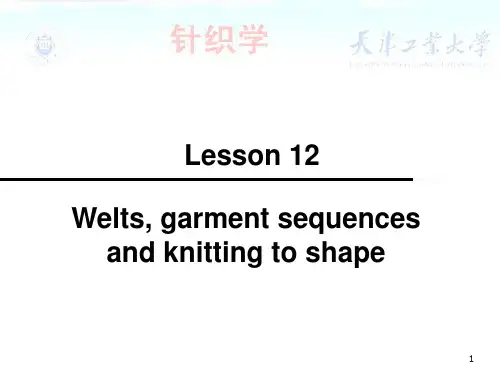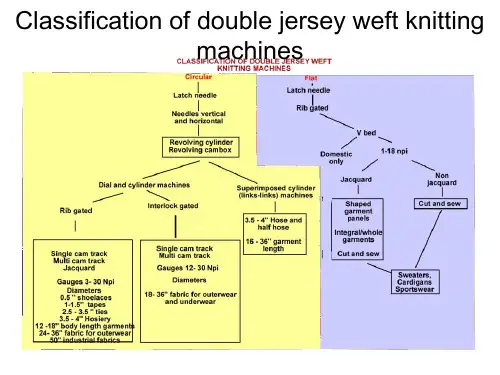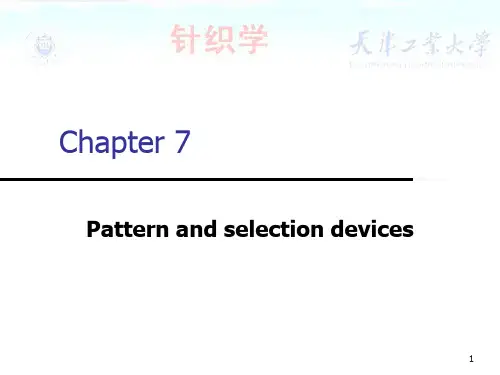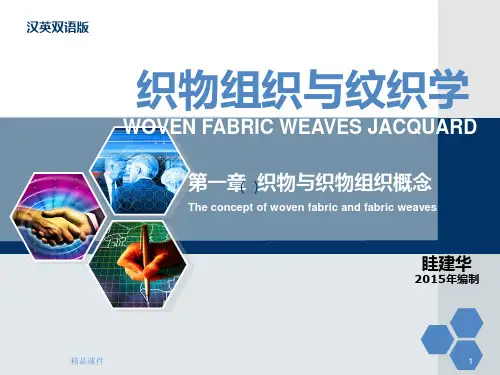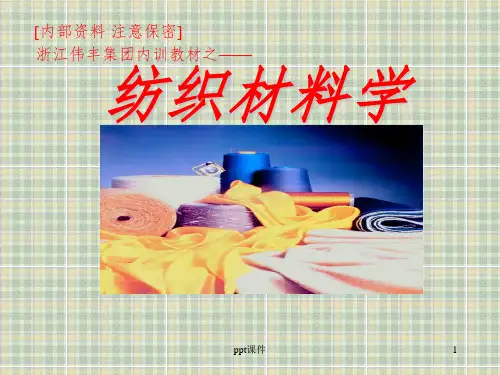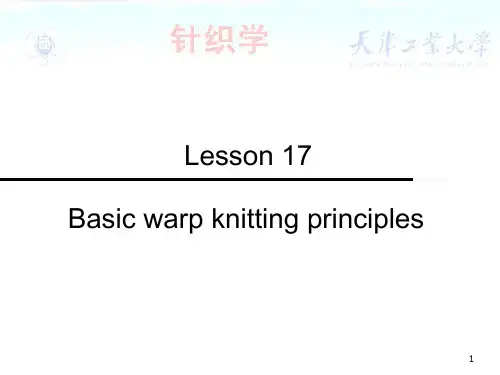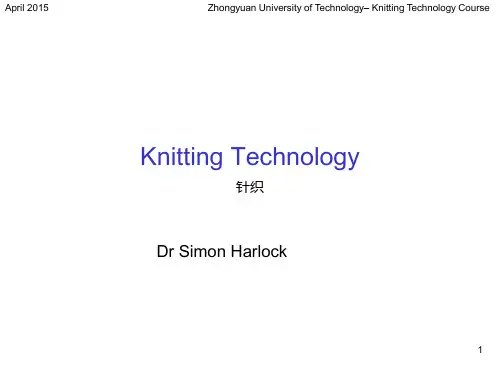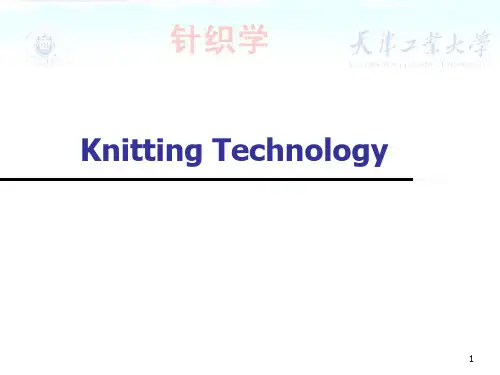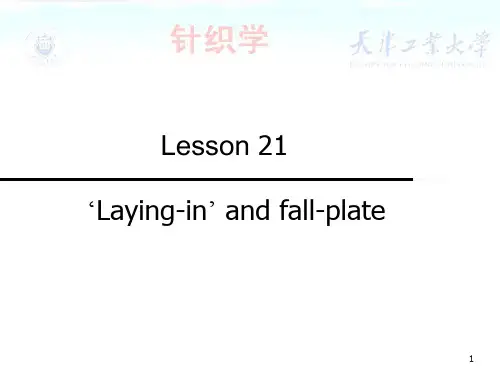- 1、下载文档前请自行甄别文档内容的完整性,平台不提供额外的编辑、内容补充、找答案等附加服务。
- 2、"仅部分预览"的文档,不可在线预览部分如存在完整性等问题,可反馈申请退款(可完整预览的文档不适用该条件!)。
- 3、如文档侵犯您的权益,请联系客服反馈,我们会尽快为您处理(人工客服工作时间:9:00-18:30)。
Lesson 15 The manufacture of hosiery on small-diameter circular machines
1
15.1 Types of hosiery
Hose, which have a leg-length extending above the knee
3
15.2 Classes of hosiery machines
Except for the few Griswold type hand-turned machines(Fig.4.4), all hosiery machines are of the revolving cylinder type. This arrangement offers the advantages of high revolution speeds, a simplified drive, and the possibility of selectively striping-in yarn from stationary packages placed at fixed feed positions around the cylinder. The three types of hosiery machines, in order of their increasing complexity and needle bed arrangement, are single cylinder, cylinder and dial and double cylinder.
Micromesh is similar although less effective because it contains less tuck stitches.
13
15.8 The development of the double-cylinder machine
The development of specifically designed circular hose machines followed from patents such as those of Newton in 1857 and McNary in 1860. During the 1870s, the patents granted to Henry Griswold virtually perfected the hand-powered sock machine.
2
Stockings, which are designed to fit the leg up to or above the knee and may or may not be selfsupporting
Tights, particularly in fine gauge, which are termed panty-hose in the USA. They may have a body section of the same knitted structure as the legs and an inserted gusset and elasticated waist-band.
11
Speeds and numbers of feeds were then gradually increased, with a six-feed machine running at 210rpm in 1963 and, by 1971, a twelve-feed machine running at 260 rpm. Today, demands for higher quality and more versatility led to a reduction in the number of feeds so that machines now generally have 4 or 6 feeds and commercial operating speeds of 1000-1200 rpm. Recently there has been an increasing use of Lycra and other elastane yarns, in bare or in covered form, at every course or at alternate courses, either by knitting laying-in or plating.
9
15.5 The advent of nylon
With only yarns such as rayon, silk, cotton and worsted available for knitting, bagginess (particularly around the ankle) of ladies’ fine gauge circular knitted seamless hose caused them to be regarded as a cheap but inferior rival to the more shapely fully fashioned hose knitted on the straight bar frame. In the same year, nylon, the ideal stocking yarn, because plentifully available. Not only was it a cheap, strong, fine and uniform yarn, it had the major asset of being thermoplastic .
12
15.7 Ladder-resist structure
Float-plated fishnet Float-plated fishnet is one popular ladder-resist structure 1 ×1 Cross tuck is another ladder-resist structure, where alternate needles tuck at alternate courevelopment of ladies’ fine-gauge hosiery machines
Circular machinery entered hosiery production inauspiciously during the nineteenth century, knitting fabric that was then cut and seamed into cheap ‘leg bags’, onto which heels, soles and toes were handframe knitted.
4
5
15.3 Gauge
On hosiery machines the gauge is usually expressed as diameter and total number of needles. A 4 inch ×400 needle single-cylinder ladies seamless hosiery machine: 400 needles to knit plain. A 4 inch ×200 needle cylinder and dial machine: 200 cylinder needles and 100 dial needles. A 4 inch ×200 needle double-cylinder machine will have a total of 200 needles to knit plain stitches in the bottom cylinder, or, when arranged for 1 ×1rib, will have 100 needles knitting plain in the bottom cylinder and 100 needles knitting rib in the top cylinder.
10
15.6 Trends in fine-gauge hosiery since 1956
The slow and expensive reciprocated and linked-closed toe was replaced on a twin-feed machine in 1956 by allcircular knitted courses of spliced fabric, which was later cut and seam shaped into a toe. In the same year, the Reymes Cole patent described how the reciprocated heel might also be replaced, in this case, by part-circular knitted splicing courses on selected heel section needles. In 1961, the four-feed Bill Zodiac machine popularised the tube stocking with a patch heel by knitting a stocking in 2 minutes 10 seconds. In the early 1950s, it took 12 minutes to knit a stocking.
7
Much of the early development of large- and smalldiameter single-cylinder latch needle machinery occurred in the USA. For many years, both in Britain and the rest of Europe, the products of these machines were considered to be inferior in quality to those knitted on bearded needle machinery or (later) latch needle machines with two needle beds.
